Classic 2D quest or how our two years of development went. Part 1
In this not very big post, I will tell you about how we made our own, as it seemed to us, small projection, and what came of it.
Attention! Under the cat there are pictures and vidosiki, carefully, traffic!

To begin with, a small digression: this article does not claim to be the ultimate truth, but in it I will try to share everything that we encountered during the development, and I hope that any of this will be useful to you. The narration will be conducted on my behalf (that is, the project programmer).
Go!
It was late autumn 2013 in the courtyard, the train was quietly doing choo-choo and carrying me on the rails back to the place from where I went to serve a year ago, the service with every kilometer of the road remained farther, and this only pleased - finally everything debts paid and now it will be possible to do the real thing! The idea of making my game was in my head for a long time, and I was hoping to put it into practice immediately upon returning home, since there was plenty of time for this now.
But I always had a problem: I couldn’t come up with a good tie, the gameplay that would suit me and which I would consider acceptable for the player, there were thoughts to copy something, but I often threw them aside, because thousands identical projects in the markets were boring even to me, a player with experience, and definitely did not want to do something the same. So a couple of months passed in thought. And fate intervened ...
The fact that I’m going to develop games was known, in principle, to many of my friends, in our places in Siberia this is an infrequent profession, I would even say rarity, but as they say, if it occurred to one person, it would come to mind and to whom something else. And on a happy tip from one of my acquaintances, my future comrade knocked on me in contact with whom we created our joint project in the future.
Sanya Subbotinov also wanted to create his own game for a long time, and the story began a very long time ago, when he was still at school. The first version of the future game was built on a flash and was a parody of quests in the game "Space Rangers", only in the castle and even with a built-in 3D scene, collected in May.
Now, Sanya, many years later, returned to the old topic and decided to cut a remake, and even inspired a plot, designed in the form of about 60 pages of printed text, describing all the intricacies of the castle. It would seem that there is even a design document, and the matter remains small, Sanya thought and decided to create a company on the newfangled crowdfunding system, namely on its Russian branch - boomstarter.
Vidos from those times remained in the bowels of YouTube. Let's get a look:
Unfortunately, then, and probably now, boom starter cannot be called a place where you can collect the amount relevant for the development of the game. The fundraising company, having collected a couple of thousand rubles, alas, failed.
But Sanya decided not to give up and make a game on his own, and one fine day, on the advice of a mutual friend, he knocked on me in PM.
A huge plus was the fact that Sanya created a whole 60 page document with full texts of scenes and even built a tree of how the action will develop in the game. This, frankly, surprised me a lot, because I didn’t see the design of documents, and, frankly, I thought it was a bit of a nonsense, since the time of examples 1C and their “The Ryaba Revenge”, but the presence of this material greatly facilitated the construction of the game in further.
At first, we planned to make a game for mobile platforms, namely Android, I already had experience building and releasing this system by that time and I approximately knew what was happening. iOS was also planned, but not primarily because of the high cost of development and the lack of necessary hardware.
So, the plan was simple - it is necessary:
a) do art, because it needs a lot (there should have been 300+ scenes in the game)
b) take and try to make a game on some engine
With point a) everything was more or less clear, but because neither he nor I really knew how to draw, it’s understandable that learning on the go what I’ve never done is stupid, and Sanya began searching for an artist while I tried to dig with different engines.
The engine. Given the features of the game that should have been in it, the requirements were simple - this is a short story with its own lotions. I discarded any new engines immediately, due to possible problems with embedding droid, ios-lotions at the launch stage, there was angengine, but it was only for the droid. I tried libgdx, which at that time was still damp, cocos2d scared C ++, which I owned, but after using C # at the university, I no longer wanted to return to it. And finally, CoronaSDK was tested, which had a fairly convenient help with examples and plugins that promised to be cross-platform. The engine at that time was paid (about $ 100), but for the sake of convenience, you could spend a little. The programming language used by Corona, in principle, I also liked for its simplicity - this is the well-known scripting language Lua.
In the meantime, in search of an artist, Sanya covered all freelance exchanges and sites related to game development topics, such as gcup.ru, gamedev.ru and others. Themes a la we are looking for talents and doing a super-game caused tons of srach and comments from couch experts who bombarded Sanya with their clever conclusions and diagnoses. However, Sanya managed to successfully send them all to the forest and spam-spam-spam ... After some time, we still found a couple of talents and were able to start work.
First, of course, we needed to create a vision of what our future character would be, and by February we had the first sketches:

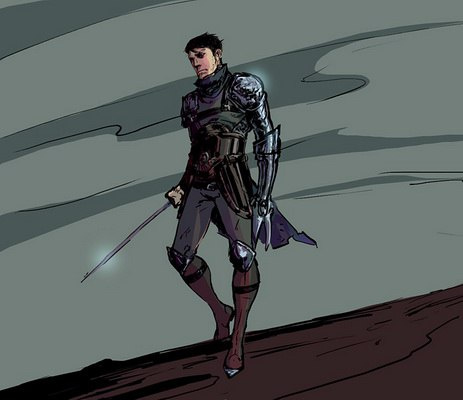
After a couple of tests, we nevertheless came to something that approximately corresponded to what we wanted:
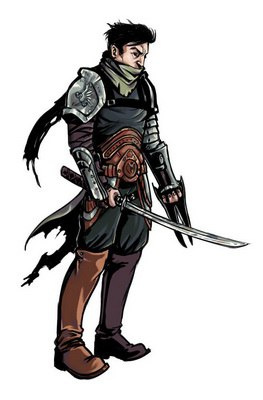
The beginning was made and we went on to the construction scenes of the game itself:

scene sketch

Scene in monochrom The

finished scene of the game
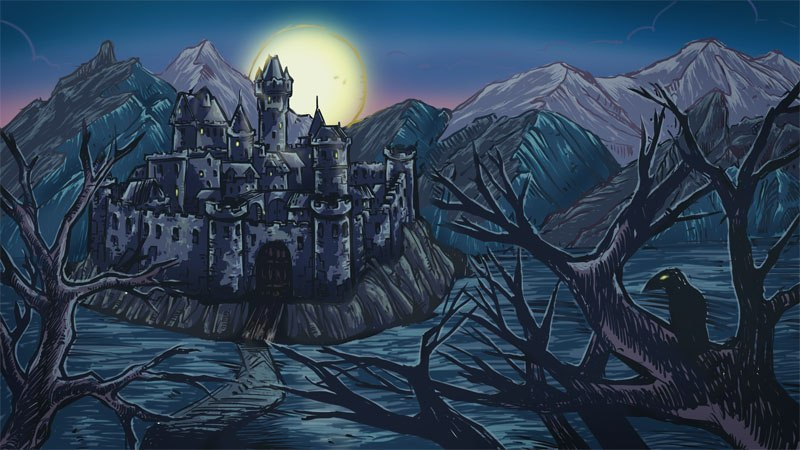
The first version of the main screen of the game, later it will change very much.
Then something happened that we did not expect, namely, the human factor. We worked with two artists: at first they painted scenes, interacted with us, and everything seemed to be going well, but at one point, the artist simply disappears and no longer gets in touch with us. After waiting a while, we began the search for another artist to continue the work, the situation repeated itself again. Belissimo!
The only thing that perhaps unites these two cases is that the artists were girls - creatures, as you know, with their cockroaches in their heads. On this, we decided to tie up interaction with individuals of the opposite sex as artists.
In the meantime, we still added a little art, from which I already collected a demo in CoronaSDK:
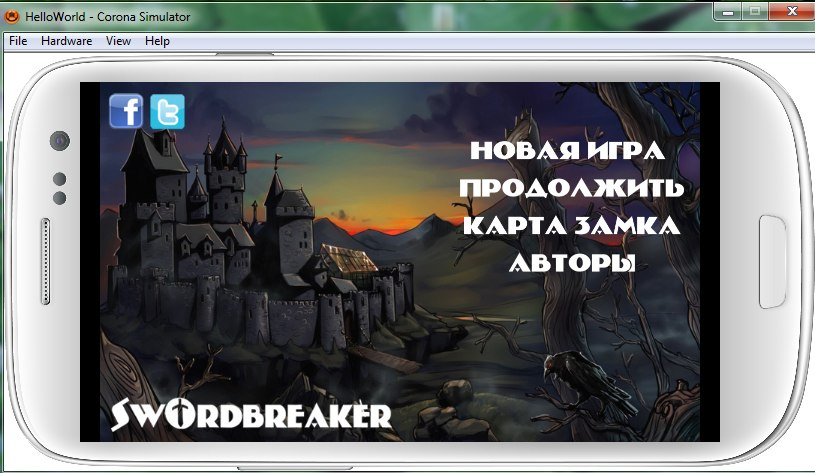
Launch in the built-in emulator

Launch the game on the phone
Impressions of the engine? Well, in general - an interesting thing, but now, looking at this engine in retrospect, I understand that only a fairly simple project can be done on this: no normal class management, scattered data on a bunch of individual .lua files, wrappers for the interface and. etc. In general, this is a working system on which, if you dodge, you can make a project, but this does not compare with how if you write in a normal good OOP language like C # or Java. Thus, after playing a couple more demos, running a couple of times on the phone, I still realized that I did not want to write the whole project on CoronaSDK.
In addition, Unity3D was tested (at that time, it did not normally work with 2D, it would take a lot to saw myself and try to wrap it in 3D, having fiddled with the camera for a couple of days and having completed a couple of tutorials I abandoned this case), the engine was also tested Construct for games on the newfangled HTML5, but this engine was very sharpened for its components and also thrown aside.
As a result, I realized one thing for myself: I want to have such a tool that would be flexible enough for a specific task and potentially have a margin of opportunity for more. From the point of view of a particular game, these, of course, were overstated requirements, but one thing can be said as a whole: I needed not just an engine, but an engine with a bias in the framework for creating games, and that was the only one for me at that time - LibGDX.
Sanya, continuing to spam forums of everything that can be found in search of an artist for the game, he was finally able to run into, as I would say, a real brulyant. Zhenya Shantarin, a very talented artist, decided to join our company. All subsequent art that is in the game is the creation of his hands. The first drafts he made really pleased us: he was able to perfectly convey the atmosphere of the game that Sanya saw. I would call it fate.
Well, the truth is not really fate ... Zhenya already had sufficient experience working not only with games, but also with other projects of game subjects, including card games, where he also acted as an artist, winning and marking for participation in competitions, well etc. In general, he was and is an advanced person in terms of graphics!

Interface outline
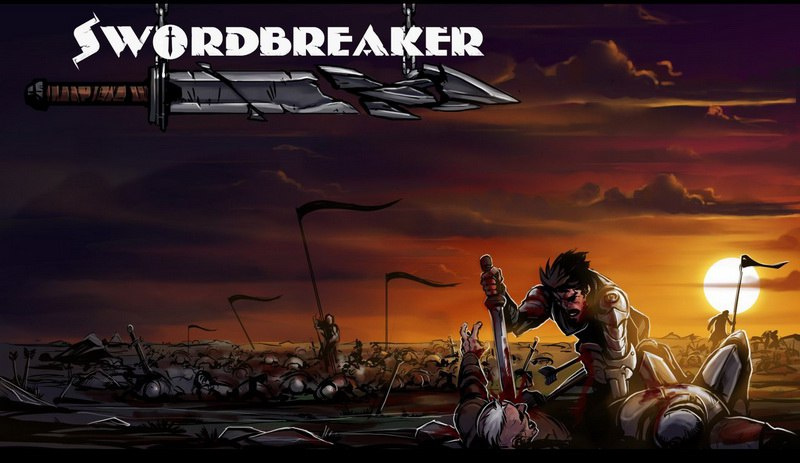
One of the new artworks
And one of the training videos created by the author himself:

Sketches
In general, Zhenya could! At this pace, we moved on: Sanya and Eugene discussed what and how to draw and put in the game, I wrote the code and tried the LibGDX engine, time passed slowly, and by the end of 2014 we had enough graphics and skills to release our own the first small application in GooglePlay, namely, a demo version of our future game.
Although at that time we didn’t even have half of everything that was needed and there was still much to be done, we still decided that we had to do this for the following reasons:
- we wanted to get experience publishing the application in the market
- we we wanted to see how players perceive a game of this genre (after all, text quests and short stories are a rather specific niche)
- we wanted to look at the advertising revenue in a free application, and how the players would react to it.
In the end, we just wanted to have at least something solid to evaluate our own work, because a whole year had already passed.
And in general - everything was successful, reviews on the market were quite positive, and the average rating at that time was 4.4 points, which seems to be not so bad.
Next time I’ll talk about how we went to the green light, how we went, what we did, how PR, and what 2015 brought us.
To be continued…
Attention! Under the cat there are pictures and vidosiki, carefully, traffic!

To begin with, a small digression: this article does not claim to be the ultimate truth, but in it I will try to share everything that we encountered during the development, and I hope that any of this will be useful to you. The narration will be conducted on my behalf (that is, the project programmer).
Go!
Background
It was late autumn 2013 in the courtyard, the train was quietly doing choo-choo and carrying me on the rails back to the place from where I went to serve a year ago, the service with every kilometer of the road remained farther, and this only pleased - finally everything debts paid and now it will be possible to do the real thing! The idea of making my game was in my head for a long time, and I was hoping to put it into practice immediately upon returning home, since there was plenty of time for this now.
But I always had a problem: I couldn’t come up with a good tie, the gameplay that would suit me and which I would consider acceptable for the player, there were thoughts to copy something, but I often threw them aside, because thousands identical projects in the markets were boring even to me, a player with experience, and definitely did not want to do something the same. So a couple of months passed in thought. And fate intervened ...
The fact that I’m going to develop games was known, in principle, to many of my friends, in our places in Siberia this is an infrequent profession, I would even say rarity, but as they say, if it occurred to one person, it would come to mind and to whom something else. And on a happy tip from one of my acquaintances, my future comrade knocked on me in contact with whom we created our joint project in the future.
Sanya Subbotinov also wanted to create his own game for a long time, and the story began a very long time ago, when he was still at school. The first version of the future game was built on a flash and was a parody of quests in the game "Space Rangers", only in the castle and even with a built-in 3D scene, collected in May.
Now, Sanya, many years later, returned to the old topic and decided to cut a remake, and even inspired a plot, designed in the form of about 60 pages of printed text, describing all the intricacies of the castle. It would seem that there is even a design document, and the matter remains small, Sanya thought and decided to create a company on the newfangled crowdfunding system, namely on its Russian branch - boomstarter.
Vidos from those times remained in the bowels of YouTube. Let's get a look:
Unfortunately, then, and probably now, boom starter cannot be called a place where you can collect the amount relevant for the development of the game. The fundraising company, having collected a couple of thousand rubles, alas, failed.
But Sanya decided not to give up and make a game on his own, and one fine day, on the advice of a mutual friend, he knocked on me in PM.
Winter - Spring 2014
A huge plus was the fact that Sanya created a whole 60 page document with full texts of scenes and even built a tree of how the action will develop in the game. This, frankly, surprised me a lot, because I didn’t see the design of documents, and, frankly, I thought it was a bit of a nonsense, since the time of examples 1C and their “The Ryaba Revenge”, but the presence of this material greatly facilitated the construction of the game in further.
At first, we planned to make a game for mobile platforms, namely Android, I already had experience building and releasing this system by that time and I approximately knew what was happening. iOS was also planned, but not primarily because of the high cost of development and the lack of necessary hardware.
So, the plan was simple - it is necessary:
a) do art, because it needs a lot (there should have been 300+ scenes in the game)
b) take and try to make a game on some engine
With point a) everything was more or less clear, but because neither he nor I really knew how to draw, it’s understandable that learning on the go what I’ve never done is stupid, and Sanya began searching for an artist while I tried to dig with different engines.
The engine. Given the features of the game that should have been in it, the requirements were simple - this is a short story with its own lotions. I discarded any new engines immediately, due to possible problems with embedding droid, ios-lotions at the launch stage, there was angengine, but it was only for the droid. I tried libgdx, which at that time was still damp, cocos2d scared C ++, which I owned, but after using C # at the university, I no longer wanted to return to it. And finally, CoronaSDK was tested, which had a fairly convenient help with examples and plugins that promised to be cross-platform. The engine at that time was paid (about $ 100), but for the sake of convenience, you could spend a little. The programming language used by Corona, in principle, I also liked for its simplicity - this is the well-known scripting language Lua.
In the meantime, in search of an artist, Sanya covered all freelance exchanges and sites related to game development topics, such as gcup.ru, gamedev.ru and others. Themes a la we are looking for talents and doing a super-game caused tons of srach and comments from couch experts who bombarded Sanya with their clever conclusions and diagnoses. However, Sanya managed to successfully send them all to the forest and spam-spam-spam ... After some time, we still found a couple of talents and were able to start work.
First, of course, we needed to create a vision of what our future character would be, and by February we had the first sketches:


After a couple of tests, we nevertheless came to something that approximately corresponded to what we wanted:

The beginning was made and we went on to the construction scenes of the game itself:

scene sketch

Scene in monochrom The

finished scene of the game

The first version of the main screen of the game, later it will change very much.
Then something happened that we did not expect, namely, the human factor. We worked with two artists: at first they painted scenes, interacted with us, and everything seemed to be going well, but at one point, the artist simply disappears and no longer gets in touch with us. After waiting a while, we began the search for another artist to continue the work, the situation repeated itself again. Belissimo!
The only thing that perhaps unites these two cases is that the artists were girls - creatures, as you know, with their cockroaches in their heads. On this, we decided to tie up interaction with individuals of the opposite sex as artists.
In the meantime, we still added a little art, from which I already collected a demo in CoronaSDK:

Launch in the built-in emulator

Launch the game on the phone
Impressions of the engine? Well, in general - an interesting thing, but now, looking at this engine in retrospect, I understand that only a fairly simple project can be done on this: no normal class management, scattered data on a bunch of individual .lua files, wrappers for the interface and. etc. In general, this is a working system on which, if you dodge, you can make a project, but this does not compare with how if you write in a normal good OOP language like C # or Java. Thus, after playing a couple more demos, running a couple of times on the phone, I still realized that I did not want to write the whole project on CoronaSDK.
In addition, Unity3D was tested (at that time, it did not normally work with 2D, it would take a lot to saw myself and try to wrap it in 3D, having fiddled with the camera for a couple of days and having completed a couple of tutorials I abandoned this case), the engine was also tested Construct for games on the newfangled HTML5, but this engine was very sharpened for its components and also thrown aside.
As a result, I realized one thing for myself: I want to have such a tool that would be flexible enough for a specific task and potentially have a margin of opportunity for more. From the point of view of a particular game, these, of course, were overstated requirements, but one thing can be said as a whole: I needed not just an engine, but an engine with a bias in the framework for creating games, and that was the only one for me at that time - LibGDX.
Summer Fall 2014
Sanya, continuing to spam forums of everything that can be found in search of an artist for the game, he was finally able to run into, as I would say, a real brulyant. Zhenya Shantarin, a very talented artist, decided to join our company. All subsequent art that is in the game is the creation of his hands. The first drafts he made really pleased us: he was able to perfectly convey the atmosphere of the game that Sanya saw. I would call it fate.
Well, the truth is not really fate ... Zhenya already had sufficient experience working not only with games, but also with other projects of game subjects, including card games, where he also acted as an artist, winning and marking for participation in competitions, well etc. In general, he was and is an advanced person in terms of graphics!

Interface outline

One of the new artworks
And one of the training videos created by the author himself:

Sketches
In general, Zhenya could! At this pace, we moved on: Sanya and Eugene discussed what and how to draw and put in the game, I wrote the code and tried the LibGDX engine, time passed slowly, and by the end of 2014 we had enough graphics and skills to release our own the first small application in GooglePlay, namely, a demo version of our future game.
Although at that time we didn’t even have half of everything that was needed and there was still much to be done, we still decided that we had to do this for the following reasons:
- we wanted to get experience publishing the application in the market
- we we wanted to see how players perceive a game of this genre (after all, text quests and short stories are a rather specific niche)
- we wanted to look at the advertising revenue in a free application, and how the players would react to it.
In the end, we just wanted to have at least something solid to evaluate our own work, because a whole year had already passed.
And in general - everything was successful, reviews on the market were quite positive, and the average rating at that time was 4.4 points, which seems to be not so bad.
Next time I’ll talk about how we went to the green light, how we went, what we did, how PR, and what 2015 brought us.
To be continued…
